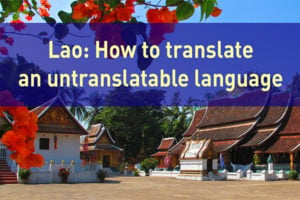In the country of Laos, made up of many ethnic groups, the population speaks about 86 different languages! The lingua franca there is Laotian, also known as Lao or Thai Noi (“lao language”). It is the official language, where it is spoken by 3 million of the country’s 5.6 million people.
Laotian is also spoken in Thailand–where it is known is Isan language–and in Australia, Cambodia, Canada, France and the US.
LAO IS VERY DIFFERENT THAN ENGLISH.
- It’s a tonal language that includes 10 vowels.
- The majority of Lao words are monosyllabic
- There are many Lao dialects throughout the countries of Laos and Thailand. The written system is based on the dialect of the Lao capital Vientiene.
- Lao’s writing system is unique. It is written in the distinctive Lao script, Tua Lao, which looks similar to Thai script, but does not derive from it. Lao was derived locally around the 14th century from the Khmer script of Angkor, is ultimately rooted in the Brahmic script of India.
OTHER LANGUAGES USE IT TOO!
Lao script is also used to write: Tai Dam, Lave, Eastern Bru, Western Bru, Mong Njua, Iu Mien, Jeh, Kuy, Kataang, Lü, Khmu, Western Katu, Lamet, Hmong Daw, Ngeq, Pacoh, Phunoi, Upper Ta’oih and Lower Ta’oih.
WHERE DID THE QUESTION MARKS GO?
Traditionally, Lao script does not use spaces between words, or ending punctuation. Spaces are used between sentences and sometimes clauses.
In more contemporary writing it is common for writers borrow punctuation marks from the French. You’ll find exclamation points !, question marks ?, parentheses (), and «» and “ “ for quotation marks. Hyphens (-) and the ellipsis (…) are also commonly found in modern writing.
HOW IS LAO SCRIPT TRANSLATED?
It’s complicated. There is no official Latin transliteration system for Lao.
- In Laos, French-based systems are used in Laos, with “considerable variation in spelling, especially in vowels.”
- In Thailand, Royal Thai General Transcription is used instead.
- Here is a sample transliteration using the transcription system that is by the British Permanent Committee on Geographical Names (BGN/PCGN). (From )
Transliteration
Manut thuk khôn kœ̄t māmīkẏat sâk sī, sitthi, sēlī phôp læ khwôm smœ̄ phôp thàw thẏam kân. Thuk thuk khôn mīhēt phôn læ khwômkhit khwôm hian swàn tôw khɔ̄̄ṅ phai khɔ̄ṅ mân, tǣ̀vồ manut thuk thuk khôn khwan paphʉt tàṁ kân khʉ̄ kân kâp pianốy nɔ̄́ṅ kân.
Translation
All human beings are born free and equal in dignity and rights. They are endowed with reason and conscience and should act towards one another in a spirit of brotherhood.
(Article 1 of the Universal Declaration of Human Rights)
Lao is a beautiful language that differs from English in some fascinating ways. But don’t let its complexity scare you! ULG’s team of native-speaking Lao translators can handle anything from marketing copy to complex legal and healthcare translation.

